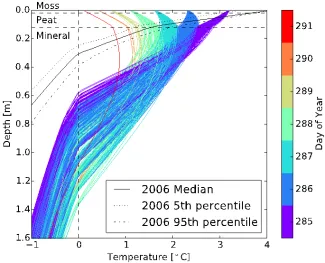Effect of Soil Property Uncertainties on Permafrost Thaw Projections: A Calibration-Constrained Analysis
We investigated the rate of permafrost thawing in a warmer climate using a model calibrated to available temperature measurements, and studied the effects of soil property uncertainties on those calibration-constrained projections. The work combined a newly developed permafrost thermal hydrology simulator, recent borehole temperature measurements, and uncertainty quantification tools. We used the model to identify 1153 combinations of soil properties that are each consistent with temperature measurements from the Barrow Environmental Observatory. We used each combination of soil properties in forward projections of permafrost conditions for the 21st century (from calendar year 2006 to 2100) using atmospheric conditions (air temperature, solar radiation, precipitation, wind speed, etc.) from the Community Earth System Model in the Representative Concentration Pathway 8.5 greenhouse gas concentration trajectory. After calibration to measured temperature data at this well-characterized site, soil property uncertainties are still significant and result in significant predictive uncertainties in projected active layer thickness (maximum annual thaw depth), even with a specified future climate. These calibration-constrained projections indicate that active layer thickness will increase by around a factor of 3, from a median of approximately 30 cm to 90 cm at this site. The active layer projections for year 2100 are from 60 cm to 140 cm. The results shown that active layer thickness is highly dependent on mineral soil porosity, while the liquid saturation of the active layer is highly dependent on the mineral soil residual saturation and moderately dependent on peat residual saturation. The magnitude of uncertainty in permafrost conditions due to soil properties, although significant, is less than that produced by climate model uncertainty at this location.
The effects of soil property uncertainties on permafrost thaw projections are studied using computational modeling. Projected permafrost characteristics such as active layer thickness and average saturation at the end of this century are quantified. The uncertainty due to soil properties is compared with uncertainty due to climate model selection.
We found that the effect of soil property uncertainties can be reduced to levels lower than the uncertainty generated by uncertainties in climate model structure through a process of calibration to field observations, model structural refinement, and calibration-constrained uncertainty analysis. However, we had the advantage of high-resolution data from the unusually well characterized DOE BER Next Generation Ecosystem Experiment (NGEE-Arctic) site, which suggests that the residual uncertainty identified here based on temperature data only is close to a practical limit.
This research was supported by the Next-Generation Ecosystem Experiments Arctic (NGEE-Arctic) project (DOE ERKP757) funded by the US Department of Energy Office of Science Biological and Environmental Research Program and Los Alamos National Laboratory’s Laboratory Directed Research and Development (LDRD) Predicting Climate Impacts and Feedbacks in the Terrestrial Arctic project (LDRD201200068DR).
For more information, please contact:
Dylan Harp
dharp@lanl.gov

